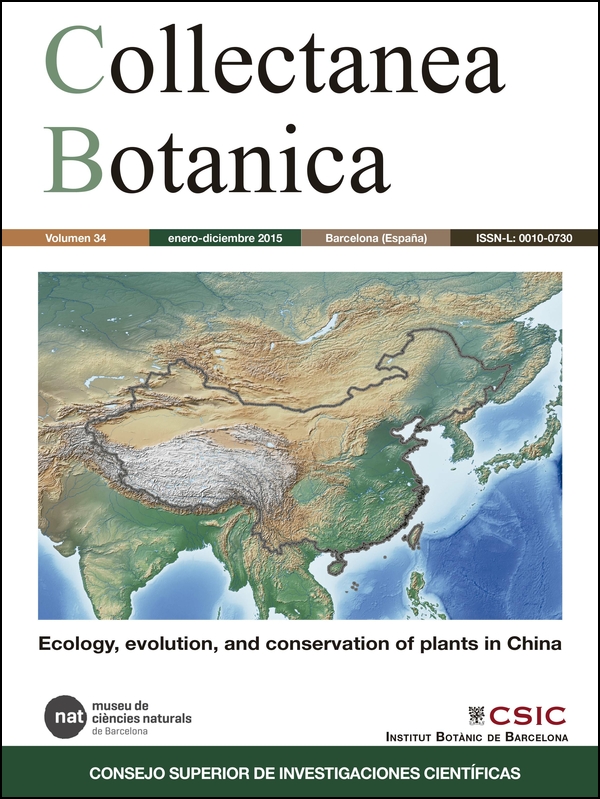Distribution patterns of long-lived individuals of relict plants around Fanjingshan Mountain in China: Implications for in situ conservation
DOI:
https://doi.org/10.3989/collectbot.2015.v34.002Keywords:
biodiversity, endemic plants, fengshui forests, glacial refugia, old treesAbstract
The mountain areas in south-central China are widely recognized as refugia of relict plants during the late Neogene and Quaternary periods. In this paper, we try to explore the distribution patterns of natural habitats and to exactly locate the refugia of relict species around Fanjingshan Mountain using dendrological data of long-lived individuals (≥ 100 years old). Six typical relict plants were found around the mountain, i.e. Cyclocarya paliurus, Ginkgo biloba, Liriodendron chinense, Pinus massoniana, Podocarpus macrophyllus, and Taxus chinensis. The long-lived individuals were divided into three classes according to their ages: Class-I (≥ 500 years), Class-II (300–499 years), and Class-III (100–299 years). Our results showed that the south-west region to the mountain was the main distribution area of Class-I trees of G. biloba and T. chinensis, most of which occurring in the same small village (Yangliu Village of Yinjiang County). The north-east region harboured all the six relict species. Floristic analyses also indicated these two regions were very similar in tree growth as measured by DBH (diameter at breast height of 1.3 m). Thus, these two areas would have provided long-term suitable habitats for relict species. The south-west region, especially the small village Yangliu, should be given highest priority for in situ conservation of relict species and other rare and endangered plants. Attention should also be paid to the north-east region for its very high species diversity of relict species.
Downloads
References
Axelrod, D. I., Al-Shehbaz, I. & Raven, P. H. 1996. History of the modern flora of China. In: Zhang, A. & Wu, S. (Eds.), Floristic characteristics and diversity of East Asian plants. China Higher Education Press, Beijing: 43–55.
Feng, Z., Yang, Y., Zhang, Y., Zhang, P. & Li, Y. 2005. Grain-for-green policy and its impacts on grain supply in West China. Land Use Policy 22: 301–312. http://dx.doi.org/10.1016/j.landusepol.2004.05.004
GFNNRAB (Guizhou Fanjingshan National Natural Reserve Administration Bureau) 2004. [ The Management Plan of Guizhou Fanjingshan National Nature Reserve. Sustainable Forestry Development Project/Protected Area Management]. Fanjinshan National Nature Reserve, Jiangkou. Retrieved December 3, 2014, from http://www.fanjingshan.cn/index1.asp
Hammer, Ø., Harper, D. A. T. & Ryan, P. D. 2001. PAST: Paleontological statistics software package for education and data analysis. Palaeontologia Electronica 4(1): 4
Li, G., Shen, Z., Ying, T. & Fang, J-Y. 2009. [The spatial pattern of species richness and diversity centres of gymnosperm in China]. Biodiversity Science 17: 272–279 [in Chinese].
Li, S-G. 1940. [On the ice sheet of Quaternary glaciations in the west Hubei, east Sichuan, west Hunan, and north Guangxi provinces]. Geological Review 5: 171–184 [in Chinese].
Li, W-H. 2004. Degradation and restoration of forest ecosystems in China. Forest Ecology and Management 201: 33–41. http://dx.doi.org/10.1016/j.foreco.2004.06.010
Liu, J., Li, S., Ouyang, Z., Tam, C. & Chen, X. 2008. Ecological and socioeconomic effects of China's policies for ecosystem services. Proceedings of the National Academy of Sciences of the United States of America 105: 9477–9482. http://dx.doi.org/10.1073/pnas.0706436105 PMid:18621700 PMCid:PMC2474515
López-Pujol, J., Zhang, F.-M. & Ge, S. 2006. Plant biodiversity in China: richly varied, endangered, and in need of conservation. Biodiversity and Conservation 15: 3983–4026. http://dx.doi.org/10.1007/s10531-005-3015-2
López-Pujol, J., Zhang, F.-M., Sun, H.-Q., Ying, T.-S. & Ge, S. 2011a. Centres of plant endemism in China: places for survival or for speciation? Journal of Biogeography 38: 1267–1280. http://dx.doi.org/10.1111/j.1365-2699.2011.02504.x
López-Pujol, J., Zhang, F.-M., Sun, H.-Q., Ying, T.-S. & Ge, S. 2011b. Mountains of southern China as "plant museums" and "plant cradles": Evolutionary and conservation insights. Mountain Research and Development 31: 261–269. http://dx.doi.org/10.1659/MRD-JOURNAL-D-11-00058.1
Qian, H. 2001. A comparison of generic endemism of vascular plants between East Asia and North America. International Journal of Plant Sciences 162: 191–199. http://dx.doi.org/10.1086/317909
Tang, C. Q., Yang, Y., Ohsawa, M., Momohara, A., Hara, M., Cheng, S. & Fan, S. 2011. Population structure of relict Metasequoia glyptostroboides and its habitat fragmentation and degradation in south-central China. Biological Conservation 144: 279–289. http://dx.doi.org/10.1016/j.biocon.2010.09.003
Tang, C. Q., Yang, Y., Ohsawa, M. et al. 2012. Evidence for the persistence of wild Ginkgo biloba (Ginkgoaceae) populations in the Dalou Mountains, southwestern China. American Journal of Botany 99: 1408–1414. http://dx.doi.org/10.3732/ajb.1200168 PMid:22847538
Wandersee, S. M., An, L., López-Carr, D. & Yang Y. 2012. Perception and decisions in modeling coupled human and natural systems: A case study from Fanjingshan National Nature Reserve, China. Ecological Modelling 229: 37–49. http://dx.doi.org/10.1016/j.ecolmodel.2011.08.004
Wang, J., Gao, P.-X., Kang, M., Lowe, A. J. & Huang, H.- W. 2009. Refugia within refugia: the case study of a canopy tree (Eurycorymbus cavaleriei) in subtropical China. Journal of Biogeography 36: 2156–2164. http://dx.doi.org/10.1111/j.1365-2699.2009.02165.x
Ying, T.-S. 2001. [Species diversity and distribution pattern of seed plant in China]. Biodiversity Science 9: 393–398 [in Chinese].
Ying, T.-S. & Zhang, Z.-S. 1984. [Endemism in the flora of China – Studies on the endemic genera]. Acta Phytotaxonomica Sinica, 22: 259–268 [in Chinese].
Zhang, J.-L. 2004. [ Old and famous trees in Guizhou Province]. Guizhou Science and Technology Press, Guiyang.
Published
How to Cite
Issue
Section
License
Copyright (c) 2015 Consejo Superior de Investigaciones Científicas (CSIC)

This work is licensed under a Creative Commons Attribution 4.0 International License.
© CSIC. Manuscripts published in both the print and online versions of this journal are the property of the Consejo Superior de Investigaciones Científicas, and quoting this source is a requirement for any partial or full reproduction.
All contents of this electronic edition, except where otherwise noted, are distributed under a Creative Commons Attribution 4.0 International (CC BY 4.0) licence. You may read the basic information and the legal text of the licence. The indication of the CC BY 4.0 licence must be expressly stated in this way when necessary.
Self-archiving in repositories, personal webpages or similar, of any version other than the final version of the work produced by the publisher, is not allowed.














